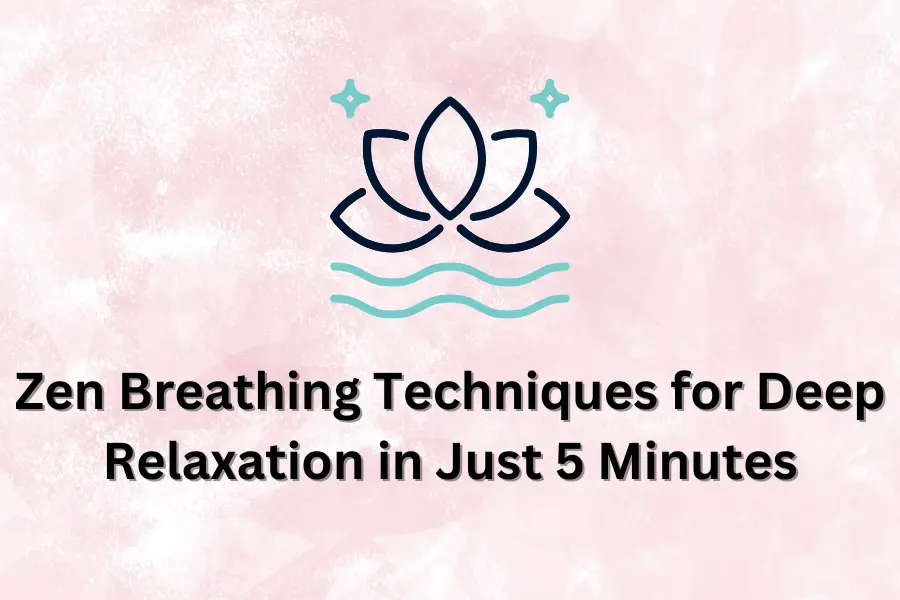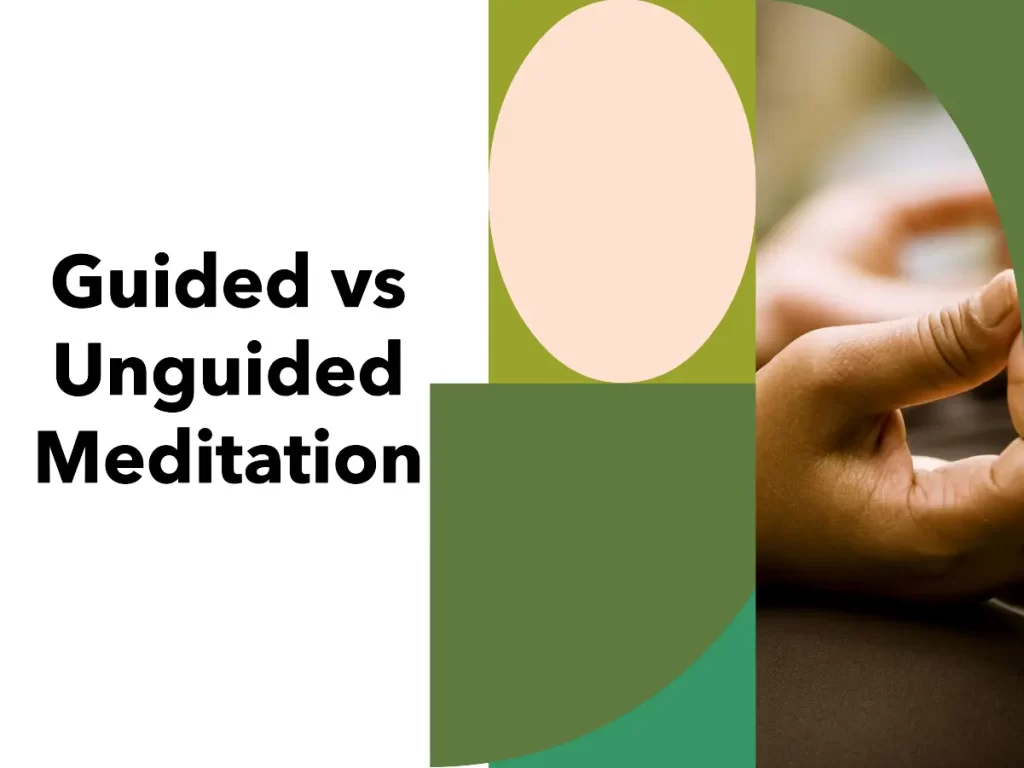Life can be stressful. Doing mundane routine activities on a loop, bearing the stress of emergencies or emotional fluctuations can be exhausting. This can leave us feeling lost and hopeless because life can feel like one scenario after another that needs to be cleaned, managed, or removed. In this toxic cycle of exhaustion, a few ancient breathing techniques can help you resolve issues and keep yourself grounded to protect your mental health as well.
In this article, we will be taking you along on a journey to discover the ancient Zen breathing techniques that can alleviate stress, anxiety, and anger issues that are affecting you. We will be discussing the benefits as well as the ways in which ancient breathing techniques can be applied effectively to calm your emotions and deeply feel a sense of peace in only 5 minutes
The Benefits of Conscious Breathing and Zen Meditation
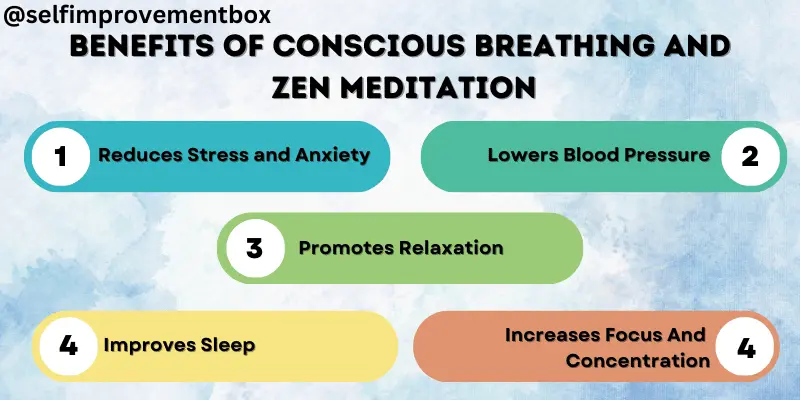

On average, scientists have found that humans can take 20,000 breaths per day. In each of these breaths, you are not even aware 99% of the time, unless you are hyperventilating or consciously trying to control your breathing. This is what Zen meditation does, it allows you to consciously breathe and be mindful of your senses. A few benefits of conscious breathing are:
- Reduces Stress and Anxiety
As you inhale and exhale feeling every muscle move with each passing second, you find the time to slow down your thoughts as well. This inadvertently reduces any stress or anxiety you may be feeling, owing to the effects of slowed breathing on mental health
- Lowers Blood Pressure
Zen breathing exercise allows the person to relax themselves. This means that if you were previously hyperventilating, now you can focus on diaphragmatic breathing during exhalation. This lowers your blood pressure, as you do not take shallow and hurried breaths.
- Promotes Relaxation
With decreased stress and anxiety that also lowers your blood pressure, one can relax. As you take a deep breath, the nervous system calms down because your brain receives signals that it can start to relax. This helps promote relaxation
- Improves Sleep
Breath meditation during pranayama is a way of breathing that can help with your sleeping patterns. It does so by producing melatonin, which is an essential hormone to promote sleepiness or drowsiness. So, exercising deep breaths right before you go to sleep or practicing yoga breathing techniques that were taught by Buddha can help you improve your sleep cycle.
- Increases Focus And Concentration
Zazen is a type of meditation technique that relies on seated meditation, with rhythmic and deep breaths. Zazen is known to improve focus and concentration, as the hara energy centre induces calmness. Inhalation through the nostrils that increases the diaphragm focuses on the hara and soto zen can help you achieve focus. Another way to understand the effects is that when you focus on your breaths and zone out of distracting thoughts, then concentrating on one thing becomes much easier.
Read Also: This 5-Minute Breath work Controls Your Nervous System like a Remote
Diaphragmatic Breathing – The Core of Zen Meditation
Diaphragmatic breathing can be explained as a deep breathing technique that engages the diaphragm, including intercostal muscles, abdominal muscles, and pelvic floor muscles. To do this kind of yogic breathing or respiration, a meditation teacher follows the basic steps that are given in the subsequent heading. The focus must be put on the increase in the abdomen by two inches and thoughts during meditation must be decreased or completely stopped, instead only concentration must be on the breathing exercise.
In diaphragmatic breathing, an awareness of breathing is important. As we conduct shallow breathing that only impacts the navel, breath awareness remains low in routine life. However, with Zen practice of breathing that requires belly breathing, it can impact your physical as well as mental health.
How to Perform the Diaphragmatic Breathing Technique?
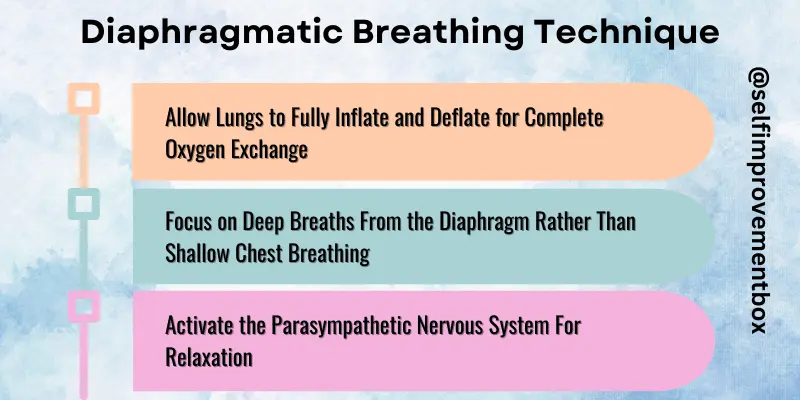

The technique for diaphragmatic breathing has been shared, although there are elements that you must focus on to ensure that diaphragmatic breathing reduces stress, and anxiety and increases concentration and focus. A few points to remember are:
- Allow Lungs to Fully Inflate and Deflate for Complete Oxygen Exchange
Deep breathing may leave you feeling like nothing has happened. This is because your breathing technique wasn’t good enough. The simple breathing method or ancient breathing strategies focus on letting your lungs fully inflate and holding in the breath. When exhaling, bring your attention to letting out all the air to completely deflate.
- Focus on Deep Breaths From the Diaphragm Rather Than Shallow Chest Breathing
The Buddha’s meditation practice focused on deep inhalation and exhalation. This means that focus during breathing is put on the diaphragm. A mistake commonly made is that focus is put on the expansion and decrease of the belly, which is not correct. Instead, your airway must exchange oxygen and your focus during this must be on the movement of the diaphragm.
- Activate the Parasympathetic Nervous System For Relaxation
Although, it is not under human control when to activate or deactivate parts of the nervous system, but Samadhi breathing techniques can help to activate the parasympathetic nervous system. This reduces anxiety and depression or any other stress disorder
Read Also: How to Unblock Your 7 Chakras and Restore Flow of Energy
Step-By-Step Guide to Diaphragmatic Breathing
- Find Relaxed Posture, Sitting or Lying Down
Sit in a comfortable position with a straight back and eyes closed
- Place One Hand on the Belly, One on the Chest
Place one hand on the chest and the second one on the abdomen. Inhale from the nose for 5 seconds, feel each muscle expand in the abdomen as your hand moves up
- Inhale slowly through the nose, and feel the belly expand
Hold your breath for 2 seconds
- Exhale slowly through the mouth, feel belly contract
Exhale from the mouth in a steady manner and feel muscles detract as your hand moves down
- Repeat this at least 15 more times
Complementary Practices for Beginners
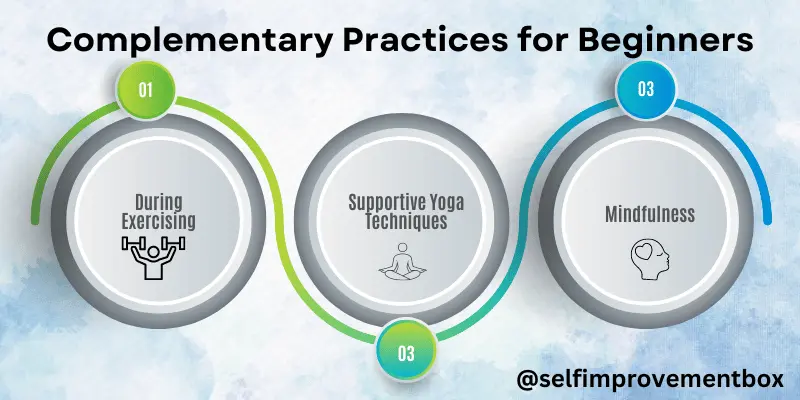

If you are new to Zen breathing techniques, then making a few adjustments to routine procedures can help you attain mind-body alignment much more effectively during anatomical breathwork. A few complementary techniques that you can follow before or after Zen breathing technique that can help maintain attention to your breath are:
- During Exercising
As you are exercising, you can practice deep breathing as well. Breathe through your nostrils, and take some deep breaths before every new set
- Supportive Yoga Techniques
To support Zen breathing techniques, certain types of yoga can help to refine your breathing strategy. For instance, the Laughter Yoga that induces manufactured laughter can help expand your lungs and abdomen to support deep breathing. Similarly, Nadi Shodhana Pranayama is a technique that focuses on alternative nostril breathing. This is good to focus on your temper, breathing and heart rate to support deep breathing
- Mindfulness
Being mindful in every life activity is also key to being better at the Zen breathing technique. Focus your attention back to the breath, whether in seated meditation, during walking, exercising, or doing any other activity. These mindful movements will help to focus on the inward life force and encourage a zazen posture at all times.
Zen Breathing and Vipassana Meditation
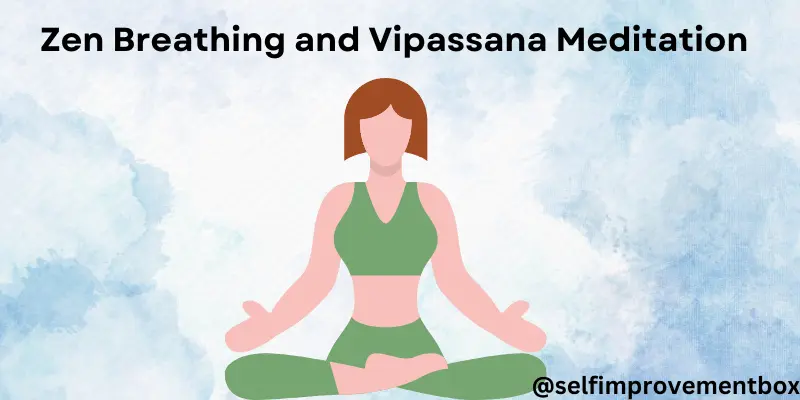

It is a form of Zen breathing technique that constitutes the larger Vipassana meditation ritual. The ancient meditation technique can be traced back to the practices of Gautama Buddha and since then, it has been adjusted and evolved to become a code of discipline to live life.
Zen breathing in Vipassana meditation can be done as a form of meditation retreat that refers to a group of people, practicing the same meditative approaches to life. However, it can also be taken up as an individual mantra of life, i.e. a form or by any means of practice that a person imposes to attain Vipassana.
Irrespective of how Vipassana is practiced, it heavily relies on deep breathing exercises. This consists of the following steps:
- Close your eyes
- Become attentive towards the belly and abdomen
- Breathe normally, no fast or slow breathing
- Focus on your natural breath
- Inhale and exhale, by focusing your energies two inches below the navel
Alternate Nostril Breathing
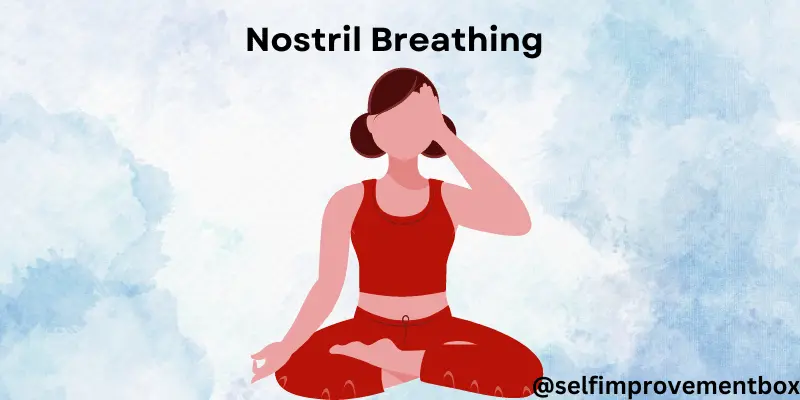

Within the Vipassana meditation that includes Zen breathing, other forms of breathing techniques can also be followed. Alternative nostril breathing is an age-old technique to focus your attention on breathing, such that asanas can be attained effectively and a long life of zazen practice can be achieved.
In alternate nostril breathing, follow these steps:
- Sit yourself in a comfortable position, with a straight back. You will find it helpful to sit on the floor with your legs crossed
- Place left hand on left knee and right hand should be on the nose
- Exhale and deflate your lungs completely
- Learn how to use your finger to alternate between nostrils. Put your thumb on the right nostril and clog it
- Breathe through your left nostril, inhale, and close the left nostril
- Unclog the right nostril and exhale through it
- Now alternate inhaling and exhaling through the right and left nostrils
- Repeat this four or six times or more if you want to
- Professionals’ opinion also states that finish by exhaling from the left nostril always, as it clears the lungs just like in the Kapalabhati Pranayama technique
In alternate nostril breathing, the benefits of deep breathing are present that can help alleviate various psychological stressors and relieve physical pain as well.
- It helps balance energy channels in the body by simply closing off nostrils and breathing in through one, out through the other
- It helps in calming your mind, such that rising and falling of the upper chest or rib cage is all you become attentive towards
- It can be used to relieve painful symptoms of COPD as well. However, please consult your doctor before proceeding, and deeper breaths are usually not allowed for patients of respiratory illnesses
Breath Counting
In Zen breathing techniques, counting down your breathing is a critical way to ensure that you maintain focus only on your breathing. In a meditative quiet room, some people find it hard to focus on their breathing, as distracting thoughts keep coming in their mind. However, these steps can help:
- Improve focus by counting breaths up to 10 then starting over
- Focus on your belly gently rising and falling
- With pursed lips, focus your attention on the airflow
The Zen Master and the Wisdom of the Buddha
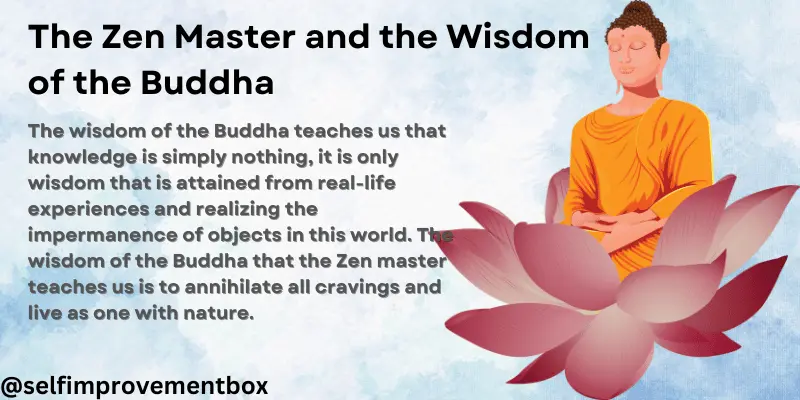

The wisdom of the Buddha teaches us that knowledge is simply nothing, it is only wisdom that is attained from real-life experiences and realizing the impermanence of objects in this world. The wisdom of the Buddha that the Zen master teaches us is to annihilate all cravings and live as one with nature
In Zen breathing techniques, the wisdom of Buddha can be applied to breathe in a way that adheres to the energy of the universe. Maximal breathing that supports motionless habitual patterns makes up the true essence of this wisdom
When done correctly, Zen breathing techniques allow us to stay present and breathe in a way so that even a feather placed right under our nose does not move. This does not simply mean to exhale slowly, instead, it is to control involuntarily done actions as well, such that our breathing is like that taught by the Buddha.
Read Also: Seiza Meditation: A Complete Guide to This Buddhist Sitting Posture
3 Mindful Steps to Better Sleep
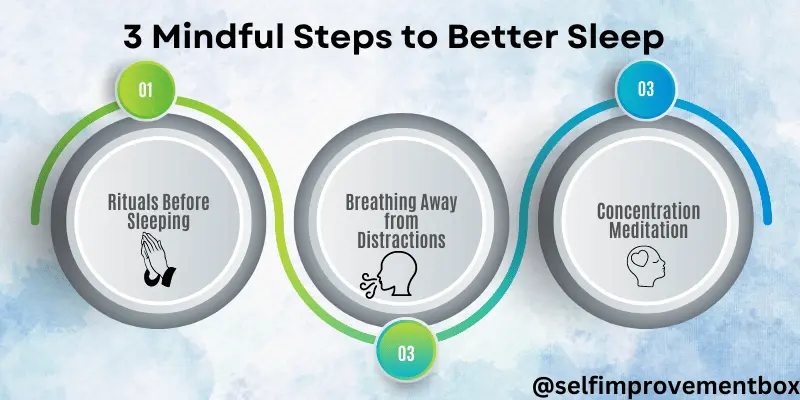

Sleep and meditative strategies, including the Zen breathing technique, are all interlinked. For better sleep, you can follow a few mindful strategies within Zen breathing that can help to take attention back from the world and into your inner world. A few strategies are:
- Rituals Before Sleeping
If you know that you have a hard time getting to sleep, then form your own ritual of a series of steps you take before getting into bed and going to sleep. These rituals can help you align your energies towards sleeping and remove any distractions that can hinder your sleep. A few examples are doing your skincare, drinking a soothing tea, reading a book in bed, or doing anything else that helps you wind down. Meditative steps can also be taken, by scheduling a yoga session before going to sleep, showering, and then getting into bed
- Breathing Away from Distractions
Once you are in bed and still find it hard to sleep, then deep breathing and Zen breathing techniques can help you manage your concentration. Focus on your breath, breathe in, and tense your body, followed by breathing out and relaxing yourself. If you find a stressful thought coming into your head, then focus on your breathing patterns
- Concentration Meditation
In case deep breathing doesn’t work, then concentration meditation while in bed can help you realign wandering thoughts. To do so, focus your attention on one subject. This can be any sensory subject, like a smell, vision or noise, or it can be focusing on a mantra, like an ‘ah’ or ‘om’.
Conclusion and Call to Action
With practice anyone can master basic Zen breathing, all you have to do is practice Zen breathing techniques throughout your daily routine and you can become a pro. You can include Zen breathing by:
- Just taking 5 minutes a day can make a big difference
- Book a free 30-minute consultation to get started
FAQ’s:
Q. What is Buddhist Breathing?
A. Zen breathing is also known as Buddhist breathing. It includes inhaling, pausing and exhale
Q. What is the Japanese Breathing Technique?
A. Japanese long breathing stretches inhaling, pausing and exhaling times from 3 to 7 seconds
Q. What are the Benefits of Zen Breathing?
A. It can:
- Alleviate stress, anxiety and depression
- Overcome wandering thoughts
- Help improve focus and concentration
Q. What is the 4-2-4 Breathing Technique?
A. It denotes the seconds required for Zen breathing technique. The technique of 4 2 4, follow three basic steps that are present in any other method:
- Inhale for 4 seconds
- Pause for 2 seconds
- Exhale for 4 seconds
Q. How Do You Do the Buteyko Method?
A. You Do the Buteyko Method
- Breathe in through your nose
- Close your mouth while inhaling and exhaling
Q. How Do Buddhists Breathe?
A. Buddhist breathing involves being mindful of your breathing in a slowed and motionless manner
- Observe your breath
- Focus on the abdomen and diaphragm
- Easy breaths must be taken so that even a feather does not move
Q. What is the Buddhist Breathing Chant?
A. Buddhist chants are taken during Zen breathing techniques, which essentially help to center the mind towards that chant and take your mind away from distractions. A common chant is ‘Om Mani Padme Hum’
Q. What is the Breath of Life in Buddhism?
A. The Buddhist reinstates that even a breath can invigorate one and help in the attainment of life. Breathing in fresh air and purifying one’s mind through mindful breathing is the breath of life.

